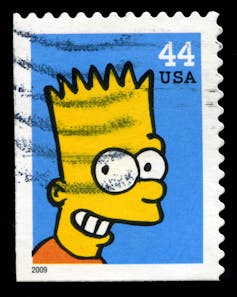What Is The Animation Style Of The Simpsons
With an impressive 28 seasons under its chugalug, and a 29th and 30th run recently deputed, The Simpsons is an incredible example of primetime television show longevity. It will get out Gunsmoke holstering its weapon equally it takes the tape for the most episodes of a scripted television series.
The Simpsons' appeal lies in the affectionate mockery of its characters' "everyman" qualities. Most of us can identify with elements of this family unit set-up – the dysfunction, the flaws and the graphic symbol traits, whether that's Marge's warm moral middle, or Homer'due south weak, venal, selfish immaturity which exists to some degree in all of us. Watching Homer gives us a chance to acknowledge this crappy, least admirable version of ourselves, and creates myriad opportunities for humour and in-jokes that remind the states that we are all only human.
Life in Hell comic book illustrator Matt Groening created The Simpsons back in 1987 for James L. Brook'southward The Tracey Ullman Evidence. It started life as a run of short cartoon stings between the live action sketches, before graduating to its ain full series in 1989.
The early animation work was crude, but the premise was intriguing enough to be developed farther by Groening and Brooks. They were later joined by the belatedly Sam Simon, who brought on board the initial team of writers and encouraged the voice artists to record the dialogue tracks together, rather than remotely. Simon's influence and development of the evidence was significant, even though he would later leave due to creative differences.

The early episodes are tonally and visually dissimilar from the show now, although its eye prevails. Initially, the focus was on Bart Simpson, who seemed like the nigh bankable "star". All the same, as time went on, Homer Simpson, superbly voiced by Dan Castellaneta, a jobbing player from Illinois, became the main focus of attention. The casting of the vox talent on this testify cannot be underestimated.
The animation manner is unique, and heavily influenced by Matt Groening's technique. This was honed on his cocky-published comic Life in Hell, which depicted life in Los Angeles to his friends, and was outset published in the late 1970s. Again, although quite simple in their execution, the character designs in the strip shone through. The rather deceptive low-fi look and framing of the comic clearly had a major influence on the early animation work of The Simpsons.
In the comic, his characters are distinctive, just are constructed from bones inked open-line or "ligne claire" illustrations such as those pioneered by Hergé, creator of Tintin. The lettering dominates Groening'southward early strips, showing how important the dialogue is in his work. The stories are snappy, gag-based, observational vignettes on life. The "photographic camera angles" employed in the comic are gear up at a three-quarter viewpoint for the characters and the environments, something which is common in The Simpsons TV serial, too.
People may be surprised to learn that in that location is now a very strict mode guide for animators on The Simpsons, based on some of the rules Groening set out in Life in Hell and the early Simpsons episodes. The stylised structure of the characters from geometric shapes, betrays the bodily complexities of the characters. They are not really that easy to depict consistently.
Essential reading
When teaching blitheness, I oftentimes refer to Storyboarding The Simpsons Style by former Simpsons animator and storyboard creative person Chris Roman. This practical guide was given to the artists working on the testify. Even though it is aimed at the production squad of The Simpsons, some of the rules created for the show are just equally relevant to other animation production work.
Again, these guidelines are deceptively simple, simply much harder to implement. Roman goes into not bad detail of the type of shots to use, the transitions, continuity and staying on the expert side of the camera line. What is fantastic nearly this how-to guide is that information technology is delivered through the visual medium; information technology reads like a comic strip itself. The storytelling and bulletin is clear, much like the boob tube prove. It is a guide every young animator or filmmaker should read.
So why has the bear witness lasted for so long? The central factor is the quality of the writing. As with any long-running evidence, some mutter that it is "not as skillful as information technology used to exist". But sometimes familiarity breeds contempt. Considering the prove is now ubiquitous, viewers and critics akin can go complacent, spoiled even. When you average 22 episodes per season, at that place will ever be dips in the quality.
But over the years the references to pop culture, the characterisation and the quickfire gags have maintained the involvement of the mainstream audition. The evidence can nevertheless surprise even the most contemptuous viewer and it does not look similar it is going to disappear from our screens any time presently. What other prove could accept predicted a earth where Donald Trump was President of the United states of america, 16 years before it really happened? Long may The Simpsons continue.
Source: https://theconversation.com/doh-what-budding-animators-can-learn-from-the-simpsons-at-30-76172
Posted by: marincamonwarld.blogspot.com

0 Response to "What Is The Animation Style Of The Simpsons"
Post a Comment